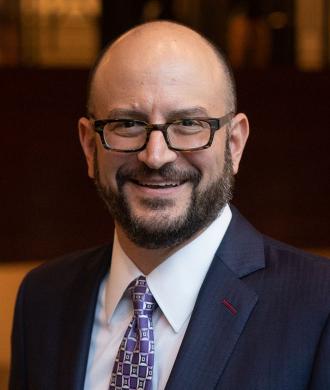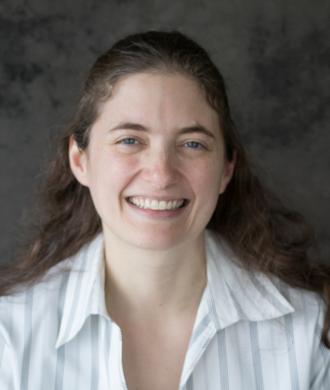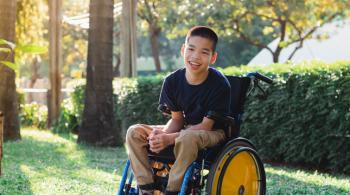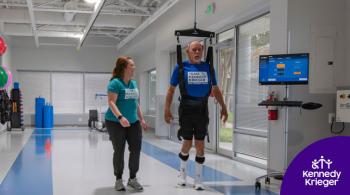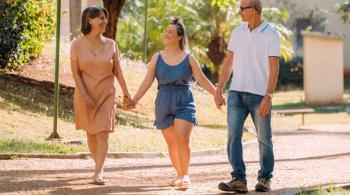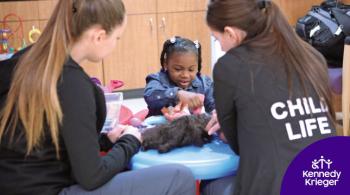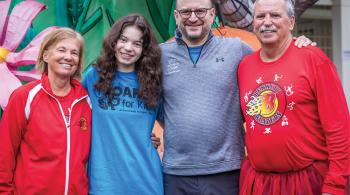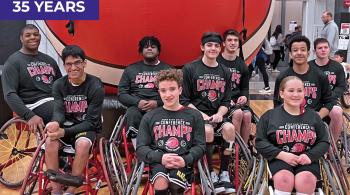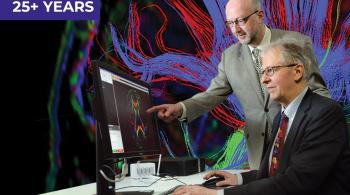KAT6a
February is nationally recognized as Rare Disease Month and to highlight this, Dr. Bradley Schlaggar, president and CEO of Kennedy Krieger Institute, welcomes Dr. Jacqueline Harris, a pediatric neurologist at Kennedy Krieger and Abby Tower, mother of five-year old Bay to discuss rare diseases and in particular KAT6a, a very rare disorder impacting Bay and her family.
Speakers for this month's episode include:
- Dr. Brad Schlaggar - President and CEO of Kennedy Krieger and professor of neurology and pediatrics at The Johns Hopkins University.
- Dr. Jacqueline Harris - Pediatric neurologist and researcher at Kennedy Krieger and an assistant professor in pediatrics, neurology and genetics at The Johns Hopkins University School of Medicine.
- Abby Tower - Abby is a parent of Bay, a very social five-year-old who has a rare disorder called KAT6a.
Learn More About Kennedy Krieger Faculty & Staff Members Featured in This Episode
Learn More About Kennedy Krieger Faculty & Staff Members Featured in This Episode
View Episode Transcription
Dr. Brad Schlaggar (BS): Welcome to Your Child's Brain, a podcast series produced by Kennedy Krieger Institute with assistance from WYPR. I'm Dr. Brad Schlaggar, pediatric neurologist and President and CEO of Kennedy Krieger Institute. Over the past several episodes of this podcast, we've talked about rare pediatric onset neural genetic diseases and the important role that research plays in this arena and the need for additional research opportunities so that we can continue to advance our knowledge and create effective treatments. There are more than 7,000 rare diseases, the preponderance of which affect the developing nervous system with more than 200 new rare diseases identified each year. It is fitting that we talk about this topic this month as February is recognized nationally as rare disease month. It is so important to underscore that advancement in this area is not possible without the input of our clinicians and our families. That's why I'm so excited today to be joined by one of my colleagues at Kennedy Krieger, Dr. Jacqueline Harris. Dr. Harris is a pediatric neurologist and researcher at Kennedy Krieger and an assistant professor in Pediatrics, Neurology, and Genetics at the Johns Hopkins University School of Medicine. Dr. Harris' area of research and expertise includes many rare diseases that we see at Kennedy Krieger. In addition, we are also joined by Ms. Abby Tower. Abby is a parent of Bay, a very social young girl who has a rare disease called KAT6a. So welcome Jackie and Abby. Jackie, just starting out with you, you specialize in neurodevelopmental disorders, specifically those with a genetic cause or some aspect. Let's first talk about how common or rare these kinds of pediatric neurological diseases are.
Dr. Jacqueline Harris (JH): Rare diseases are by nature individually rare, but they are collectively common. It's estimated that about one in every 10 people in the United States suffers from some sort of rare disease. Pediatric neurodevelopmental disorders are in and of themselves, relatively common. Intellectual disability, which is the area of expertise that I specialize in, occurs in about 1% of the general population. However, the genetic causes of intellectual disability, range. The most common genetic causes of intellectual disability, like say Down syndrome, occurs in about one in every 700 births. Whereas the most rare conditions don't even have an estimate of their prevalence because they are so rare. For example KAT6a syndrome, which we're going to be talking about today, has about somewhere in the range of 300-400 known cases in the world, and so no prevalence estimate is yet available.
BS: We've used this term a genetic cause or a neurogenetic disease, let's just take a moment to talk about what does it mean to have a genetic reason for a neurodevelopmental disorder.
JH: In this case, when we're talking about genetic causes of intellectual disability or neurogenetic diseases, we are talking about a single identifiable genetic cause for the person's intellectual disability or other neurodevelopmental disorder. Many neurodevelopmental disabilities are heritable in that they come from multi-factorial, genetic, and familial causes. In this case, what we're talking about is a single identifiable cause that is inherited through the genes or occurs newly in the child through their genes, that causes their neurodevelopmental disability.
BS: Diving a little bit deeper, you are an international expert in a certain genetic disorder called Mendelian disorders of the epigenetic machinery. Can you help listeners understand what that name means and how these disorders are different from other genetic disorders?
JH: Absolutely. Mendelian disorders of the epigenetic machinery mean disorders that are inherited in a Mendelian fashion. Meaning they can be passed along from parent to child in some way. Whether that be recessive, meaning you need two copies or dominant meaning you need one copy. Although most of these cases occur de novo, meaning they occur newly in the patient and are not actually passed down. They are disorders of the epigenetic machinery because they are disorders that affect proteins that control the ability of many other genes to be made into proteins, which at the end of the day is the primary function of genes to create proteins that then carry out the effect in the cells that we see in the body.
BS: Can you name a few of these disorders that you studied and treated that fit into this category of Mendelian disorders of the epigenetic machinery? What are some of the symptoms of these disorders? Are they common, do they have similar syndromic presentation, common sets of symptoms, or do they vary?
JH: What's very interesting about the Mendelian disorders of the epigenetic machinery is that each and everyone is individually rare. They can range from, again, things like KAT6a syndrome that have only a few hundred cases known in the world to something like Kabuki syndrome, that occurs in about one in every 32,000 or so live births. However, collectively, as a whole group, Mendelian disorders of the epigenetic machinery are estimated to encompass about 40% of the genetic intellectual disability syndromes that we discussed earlier. Together, these are a huge cause of syndromic or genetic intellectual disability. They share this neurodevelopmental disabilities presentation showing that these epigenetic proteins are incredibly important for the function of the brain. They are different in their specific syndromes from their cognitive presentations and profiles to the other organ systems that are involved. But they almost universally affect the brain and cognition and neurodevelopment.
BS: That 40% number that's really fascinating. It's only in recent years that we've come to understand that proportion of intellectual and developmental disability being attributed to this family of diseases and mechanisms. Could you just speak a little bit to that? What the journey has been like to understand the contribution of this mechanism for genetic disease and how we've learned about them over the past, say, 10, 15, 20 years.
JH: Absolutely. It parallels the journey we've been on in genetics in general, where a couple of decades ago we were really focused on just finding genes and identifying genes that cause different things. We had this explosion of genes that cause autism, genes that cause intellectual disability, etc. But nobody knew much about the proteins that those genes made and how they actually function. Now, while we continue to discover more and more genes that do cause these neurodevelopmental disabilities we're starting to delve deeper and learn more about what these genes and the subsequent proteins created actually do. One of the patterns that is emerging is that epigenetic functions, which again means proteins that affect the ability of other genes to be made into proteins and then carry out those functions are incredibly important in the nervous system. They're important for many areas of the body, which is why these syndromes tend to have many organ systems involved. But in particular, the nervous system is extremely sensitive to these proteins. In addition, something that we're learning is that these proteins have what we call dose-dependent. Meaning there are many diseases in which even if you just have a little bit of the protein,the person can carry out their normal day-to-day functions and the brain works appropriately. In these particular syndrome, that's not the case. You need 100% contribution of what you're supposed to have as far as the protein dose. Not too much and not too little in order to have normal brain function.
BS: Let's dive in to KAT6a. You told us that it's only several hundred that have been identified worldwide. How does this disorder show up in children? How is it most commonly diagnosed at this point?
JH: KAT6a syndrome is almost universally diagnosed by genetic testing. While there are many symptoms that you can see over and over again in the children with KAT6a syndrome, they still are broad as far as many other syndromes can cause some of these same presentations. It really requires broad genetic testing, usually a test called whole exome sequencing that results in the diagnosis of this condition. What you see is that these children are affected from birth. They are born quite with low muscle tone or hypotonia. Then early on you generally see significant delay in development of all the developmental milestones that you would expect a child to have. Later on as the children get older, one thing that is unique and interesting about KAT6a syndrome is they had a specific significant deficit in language as compared to all their other developmental skills. While they are globally delayed, meaning the developmental skills are behind across the board, their language is much more impacted. For these reasons, having a diagnosis of KAT6a is actually very important. Even though the symptoms are only currently treated with therapy modalities and educational accommodations, it's very important to know you have KAT6a because then we can very early on start to institute other modalities of communication beyond speech to enable these kids to thrive in their environments.
BS: We've been just throwing out the name of the diagnosis KAT6a. We haven't actually said why it's called KAT6a. By the way, it's K-A-T-6a, not cat like the house pet. Can you just tell us where does that name come from? It's jargony, but what does it mean?
JH: Absolutely. The K is the protein symbol for lysine, which is one of the amino acids or the building blocks of proteins, AT stands for acetyltransferase, and then 6a is just the designation that it is the Number 6a lysine acetyltransferase. That name gets back to that Mendelian disorders of the epigenetic machinery again. KAT6a is a protein that places acetyl groups on another type of protein called histones. Histones are what wrap the DNA and make it able to open and close and therefore available for making proteins. The lysine acetyltransferase protein places these acetyl marks on histones, thus enabling the DNA wrapped around the histones to be available for making proteins. When you have KAT6a syndrome, you lose one copy of this protein that places these acetyl transfer marks. That has significant effects on the whole body and especially the brain, thus causing KAT6a syndrome.
BS: Jackie, in your lab, what are the questions that you're trying to answer about this disorder, or perhaps about disorders like KAT6a, these epigenetic machinery-related disorders? What are you trying to tackle in your own work?
JH: One thing that's very interesting about these epigenetic disorders is that like we said, there's a dose dependence to it, and these proteins all exist in a very delicate balance with each other. Because of that, there may be ways in which treatments or interventions can affect this dance or this balance between the epigenetic proteins even if the protein or the gene remains broken or changed from what we would expect. Because of this, this makes these disorders potentially treatable, including the neurologic manifestations of these disorders. I have many colleagues and collaborators who work on discovering these treatments. At the same time, my lab works on understanding in-depth the cognitive and behavioral and developmental phenotypes or presentations of these disorders, KAT6a and related disorders, so that when it comes time to test the interventions that my colleagues work on, that we are ready to go for clinical trials in these potentially treatable conditions. The other thing that my lab works on is understanding overlap between the different Mendelian disorders of the epigenetic machinery because as we said, KAT6a is exceedingly rare, for example. It's hard to do a clinical trial in something that only 350 people in the world have, but it's a lot easier if you can combine disorders that have both molecular or genetic similarities, as well as similar presentations or symptoms that the patients have. These could potentially be enrolled in a clinical trial together and share the same potential treatments.
BS: Just one more question before we turn our attention to Abby. Your expertise in this area is clear. I just want to make sure everybody understands that you are a pediatric neurologist seeing patients, but it's an important part of your day to day. The research is key, but so is your clinical service. Can you just comment on, from your perspective as a treating physician, what impact do you see as having a child with this disorder have on both the child experience as well as the family?
JH: I would call it an all encompassing experience for both better and worse. For example, these children have multiple what we call comorbidities or other issues beyond just, for example, their neurodevelopmental presentation. Kids with KAT6a syndrome, as an example, often have heart issues, they often have vision issues, they have significant feeding and GI issues almost universally as a part of their presentation. Their neurodevelopmental issues are complex. They have sleep issues. They have the severe speech issues that we discussed earlier, and the low muscle tone that makes their physical capabilities more difficult. This affects what they're able to do in school, this affects what they're able to do around the house and how they're able to take care of themselves. It affects how they interact with other children. At the same time, when you have a child who has these impairments and you often get focused on it, small victories are incredibly also all encompassing. Things that many parents might take for granted when you see it in a child who has KAT6a syndrome, for example, is really exciting and something to be celebrated. As I believe, Ms. Tower is going to tell you about these kids are in many ways just joys to be around and they are lights of their family. Both from a difficulty standpoint as well as a joy standpoint, these are truly all encompassing conditions for not just the patient, but their entire family and caregiver support network.
BS: Abby, could you tell us a bit about your daughter, Bay?
Abby Tower (AT): Bay is the oldest of three. She diagnosed with KAT6a when she was eight months old. We knew from birth that there was something off. We knew she had a heart defect prenatally, but after birth clearly, she had multiple medical issues, as Dr. Harris said, like the low tone amongst others. She was dependent on oxygen for quite some time. The feeding difficulties that Dr. Harris spoke of were definitely evident for Bay. She wasn't able to take by mouth enough nutrition, so automatically had a feeding tube. A lot of other medical issues that we didn't have answers to as to why or actually what was going on. She ended up in the hospital for eight weeks before going home and ultimately ended up with a feeding tube due to the significant feeding issues. She was diagnosed with KAT6a through the whole exome sequencing at eight months old. I think we were Number 67 at that point. That's showing you how the KAT6a community has grown to around 300 at this point.
BS: With KAT6a being such a rare diagnosis and Bay being Number 67, as you just pointed out, have you been able to connect with other families with the same diagnosis or maybe related diagnoses? How have you been able to learn more about KAT6a, perhaps through this connectivity with others?
AT: There is a wonderful support group on Facebook of the KAT6a families. I think the day that we got diagnosed, we went home and went searching for KAT6a on the world of Facebook and found a group. It's a group of amazing people who know all things KAT6a as far as [LAUGHTER] families go through what they know, challenges, the struggles. Found a whole bunch of people who had kids just like mine, struggles looked exactly, a lot like mine. It's a huge spectrum of symptoms very significant, severe symptoms to pretty high functioning as well. It can be an encouragement to families down the road. As far as when your child gets older. This is what life looks like for this family because typically in KAT6a, the first three years, the first year is just very tough, a lot of medical challenges. The feeding, the sleep issues Dr. Harris talked about and the medical complexities, just figuring out how to deal with them and how, what physicians to see, what specialist to plug into, it's just a lot and overwhelming and developmentally the delays as far as even like rolling over, sitting up, or crawling, or walking, it's just really tough and a lot to work through the various therapies and then at home as well.
BS: These family networks really matter immensely?
AT: They do and actually we're about to have number four of our KAT6a conferences, where families can actually in-person physically meet. We actually have a KAT6a families map throughout the world that someone keeps up with. Sometimes when people are in town to see Dr. Harris, I've had the opportunity to meet those families because well, since we were local. That's been really great opportunity. There's another family in West Virginia who has a child just about the same age as Bay and it's very much like [inaudible 00:22:12], I was the first KAT6a family that they had met and it was just awesome, they've never met anyone else with KAT6a in-person.
BS: Can you take us through what a typical day is like for you and Bay maybe that includes school or therapies. What does it look like?
AT: Sure. Bay, Monday through Friday is school days, goes to a public school. In the morning she sleeps in an enclosed bed for her safety, for wandering and what-not that can happen otherwise. Probably takes about half an hour, 45 min to actually have her wake up. Then getting her ready for school. She can get dressed for the most part, but you're getting her clothes and giving them to her. She is not toilet training as of yet and so there's that process as well. She has a G-tube, gastrostomy tube that she gets medications through them in the morning. She does not drink enough liquids, we support that with water through her feeding tube. At that point, after that she gets on the bus and it takes her to school. She goes to a general education school, but she, her classroom she has a special education classroom separately housed in the school. They focus on functional learning. They have their own curriculum modified. The students also participate in general education classes like specials, like library and art. They play out on the playground with the other general education students. From what I understand, the first grade class of girls seek out Bay and play with her on the playground. Apparently she goes for first shift and second shift of recess. Then school's over at four. She comes home on the bus as well, and then we just do our dinner routine and then more water, more medication by tube. She's just learning to chew solid foods. That's been a very long process. She's working on that. As far as therapies. She goes to physical therapy and occupational therapy once a week and she's doing speech therapy twice a week. We're just about to start another therapy as well, hypnotherapy, which is one of [inaudible 00:24:51].
BS: How would you characterize in real terms, what you think are the most significant challenges now and how you anticipate a pathway forward?
AT: Most significant challenge is language communication, but also in her education. Unlocking how to teach her and help her excel in academics and life skills to help her develop to the best of her potential. I think when you have a non-verbal child, it's difficult to, or even a non-verbal child with intellectual disability it takes a whole lot to figure out how to access teaching them in the proper way.
BS: Absolutely. This concept of unlocking and all those clinicians that you're working with their task, and teachers in tandem with you is to find that way and to unlock her specific, an approach to education and communication that will work for Bay. Well said, that's how we see it as well certainly. The flip is that for those of you listening in, we are looking at each other on camera. What I see is a smiling and really social little girl looking back at me, which is just a delight, I wish you could see it. Abby, are there particular moments when you've been the most proud of Bay, what are those moments like and how would you characterize how, the way she handles her challenges, how that makes you feel pride?
AT: She's the hardest worker I know and she's just a kid. She has neurotypical siblings, so you see them meet milestones and for us when Bay has reached milestones it's typically epic, she worked hard to get there and she's just really does it with a smile. As she gets older she knows the significance of what she's doing, what she's done, and I think just you lights up and you can just see it, and she understands and that she knows she's been working hard and like this gift she's obtained this skill.
BS: What would you say are your hopes for the KAT6a research that Dr. Harris and her team and others who are working in this space, what are your hopes for what they are going to be able to accomplish?
AT: Available treatment that could help improve the quality of our kids lives. Life is hard for Bay, life is hard with KAT6a. Even like anything improved for the kids for the adults with KAT6a, would just be a amazing.
BS: The research piece of this for precisely that reason is so important. I'll turn it back to you, Jackie. What do you see are the biggest challenges or obstacles for you and your research? For example, if someone listening wants to help families like Bay's, what can they do?
JH: One of the biggest challenges when you study rare disease is right there, that the diseases are incredibly rare. With 350 families across the world trying to learn about this disorder and how it affects everyone and how we can treat it, is challenging. What we really need is more awareness so that people who hear about this, know what it is, and know even if not specifically about KAT6a about the idea of rare diseases that cause neuro-developmental disabilities and how important it is to treat them. How this can be a window into understanding neuro-development in everybody. How understanding how one specific genetic change can totally upend the neurologic development of a person, helps us understand how we all function and how we all can optimize our brains. What's needed is funding in all phases of everything, we need funding for the research itself. Research tests and materials are expensive. We need funding for the families if there's only 350 of them and some of them are in Europe, in Australia, in Africa, we need to get these families somehow to Baltimore, whether that's virtually whether that's in-person, whatever that means, we need to figure out how to do that. All of that takes funding, and awareness builds funding so doing events, doing walks, things like that can really really help increase the awareness and then eventually increase that funding. Then in general, one of the biggest things is just a general awareness, understanding, and compassion and empathy for people with neuro-developmental disabilities and neurodevelopmental disabilities from everyone who has a more mild neuro-developmental disability like someone more high-functioning on the autism spectrum to someone who has some more severe impairments, like Ms. Bay, who is as wonderful and as delightful as you could ever be and, as mom said, has kids seek her out on the playground to play with her, but isn't going to be able to talk to her friends, isn't going to be able to communicate with them in a typical manner. Having your family, your children, everyone around, you have a better understanding of how to communicate with, how to be comfortable around people with different levels of neuro-developmental disability is something we all can do and it's incredibly important.
BS: That is a great point to end on. I want to thank our guest, Dr. Jackie Harris, Ms. Abby Tower, and Ms. Bay Tower, and to our listeners, we hope that you found this information helpful and interesting and that you'll tell your friends and family about our podcasts and rate us if you're so inclined. Please check out our entire library of topics on your child's brain at wypr.org, KennedyKrieger.org, wypr.org/studios or wherever you get your podcasts. You've been listening to Your Child's Brain. Your Child's Brain is produced by Kennedy Krieger Institute with assistance from WYPR and producer Spencer Bryant. Please join us next time as we examine the mysteries of Your Child's Brain.

